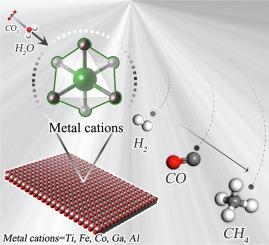Science Bulletin ( IF 18.8 ) Pub Date : 2020-03-23 , DOI: 10.1016/j.scib.2020.03.032 Xuyang Xiong 1 , Yufei Zhao 2 , Run Shi 3 , Wenjin Yin 4 , Yunxuan Zhao 1 , Geoffrey I N Waterhouse 5 , Tierui Zhang 1

|
Photocatalytic CO2 reduction holds promise as a future technology for the manufacture of fuels and commodity chemicals. However, factors controlling product selectivity remain poorly understood. Herein, we compared the performance of a homologous series of Zn-based layered double hydroxide (ZnM-LDH) photocatalysts for CO2 reduction. By varying the trivalent or tetravalent metal cations in the ZnM-LDH photocatalysts (M = Ti4+, Fe3+, Co3+, Ga3+, Al3+), the product selectivity of the reaction could be precisely controlled. ZnTi-LDH afforded CH4 as the main reduction product; ZnFe-LDH and ZnCo-LDH yielded H2 exclusively from water splitting; whilst ZnGa-LDH and ZnAl-LDH generated CO. In-situ diffuse reflectance infrared measurements, valence band XPS and density function theory calculations were applied to rationalize the CO2 reduction selectivities of the different ZnM-LDH photocatalysts. The analyses revealed that the d-band center (εd) position of the M3+ or M4+ cations controlled the adsorption strength of CO2 and thus the selectivity to carbon-containing products or H2. Cations with d-band centers relatively close to the Fermi level (Ti4+, Ga3+ and Al3+) adsorbed CO2 strongly yielding CH4 or CO, whereas metal cations with d-band centers further from the Fermi level (Fe3+ and Co3+) adsorbed CO2 poorly, thereby yielding H2 only (from water splitting). Our findings clarify the role of trivalent and tetravalent metal cations in LDH photocatalysts for the selective CO2 reduction, paving new ways for the development of improved LDH photocatalyst with high selectivities to specific products.
中文翻译:

含三价或四价金属的锌基层状双氢氧化物选择性光催化 CO2 还原
光催化 CO 2还原有望成为燃料和商品化学品制造的未来技术。然而,控制产品选择性的因素仍然知之甚少。在此,我们比较了同系列锌基层状双氢氧化物 (ZnM-LDH) 光催化剂对 CO 2还原的性能。通过改变 ZnM-LDH 光催化剂(M = Ti 4+、Fe 3+、Co 3+、Ga 3+、Al 3+)中的三价或四价金属阳离子,可以精确控制反应的产物选择性。ZnTi-LDH还原产物主要为CH 4 ;ZnFe-LDH和ZnCo-LDH产生H 2完全来自水分解;而 ZnGa-LDH 和 ZnAl-LDH 产生 CO。应用原位漫反射红外测量、价带 XPS 和密度函数理论计算来合理化不同 ZnM-LDH 光催化剂的 CO 2还原选择性。分析表明, M 3+或 M 4+阳离子的d带中心 ( ε d ) 位置控制 CO 2的吸附强度,从而控制对含碳产物或 H 2的选择性。d带中心相对接近费米能级的阳离子(Ti 4+ , Ga 3+和 Al 3+ )强烈吸附 CO 2产生 CH 4或 CO,而d带中心远离费米能级的金属阳离子(Fe 3+和 Co 3+)吸附 CO 2较差,从而仅产生 H 2(来自水分裂)。我们的研究结果阐明了三价和四价金属阳离子在 LDH 光催化剂中对选择性 CO 2还原的作用,为开发对特定产品具有高选择性的改进型 LDH 光催化剂铺平了新途径。











































 京公网安备 11010802027423号
京公网安备 11010802027423号